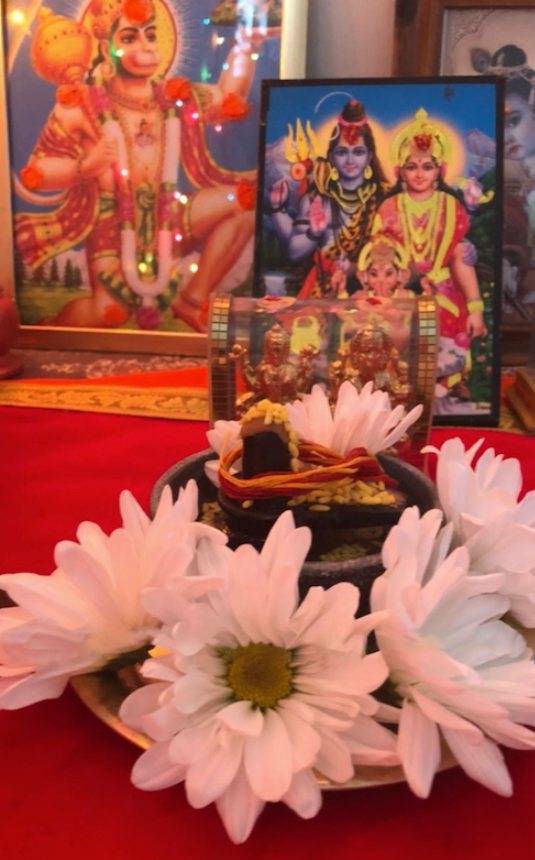

Venerating the Shiva Linga during Shravan. Photo by Swati Arun.
I am a Hindu woman who grew up in the vibrant cultural landscape of Northern India where the month of Shravan holds a special place. This sacred Hindu month, corresponding to July-August in the Gregorian calendar, is a time of deep spirituality, rich traditions, and personal reflection. I observe a fast every Monday during Shravan, reconnecting with my roots and embracing the spiritual essence of this auspicious period.
Significance of Shravan
Devotion to Shiva: Growing up, I was always fascinated by the stories of Shiva, the Supreme Being in Shaiva Dharma, and the epitome of asceticism and compassion for Sanatani Hindus. Shravan is intrinsically linked with his veneration and the period when Shiva consumed the poison from the churning of the ocean (Samudra Manthan) to save the world. This act of supreme sacrifice gives Shravan a deep reverence for Shiva devotees.
Spiritual Practices Rituals and Fasting: Observing fasts (vrata) during Shravan, particularly on Mondays, known as Shravan Somvar, is a practice I hold dear. Not only does fasting have health benefits, such as giving our digestive system a break, but it also helps strengthen the devotee’s willpower and mental control over the senses. On Mondays, I recite chants and dedicate ceremonial gifts in front of the Shiva Lingam, the sacred aniconic form of Bhagavan Shiva. Visiting Shiva temples, chanting his famous mantra “Aum Namah Shivaya,” and ceremonially bathing the Shiva Linga are integral parts of these observances. In my household, we abstain from non-vegetarian food, and alcohol, dedicating our time to chanting and meditation.
Kanwar Yatra: One of the most remarkable sights during Shravan is the Kanwar Yatra. Devotees, known as Kanwariyas, carry pots of holy water on their shoulders as they walk on foot from the Ganga and other sacred rivers to Shiva temples near their homes, covering distances of hundreds of miles in some cases. Witnessing their unwavering faith and endurance is inspiring. While I haven’t participated in the Kanwar Yatra personally, my parents did and I enjoyed the collective energy and devotion of the pilgrims which filled me with a sense of awe.
Cultural Festivities: Shravan is also a time for vibrant cultural celebrations. In Northern India, festivals like Teej and Naga Panchami add to the festive spirit. I have fond memories of participating in Teej, a festival celebrated by women with great enthusiasm, involving beautiful mehndi designs, swings, and songs. These celebrations bring communities together, fostering a sense of unity and joy.
Environmental Significance: The monsoon rains during Shravan rejuvenate the land, symbolizing renewal and fertility. Growing up, I have seen how farmers celebrate the rains with gratitude. This connection with nature is a vital aspect of Shravan, reminding us of the cycle of life and the importance of living in harmony with the environment.
Stories: Shravan is rich with legendary tales. The story of Shravan Kumar, a devoted son whose tragic death influenced key events in the Ramayana, is one such tale that deeply resonates with me. Shravan Kumar, known for his unwavering devotion to his blind parents, carried them on his shoulders on a pilgrimage. Tragically, he was accidentally killed by King Dasharatha, who mistook him for a wild animal while hunting. Shravan’s dying wish was for his parents’ welfare, but his parents’ curse on Dasharatha led to many significant events in the Ramayana, including the exile of Dasharatha’s son, Ram.
These stories, passed down through generations, add a layer of historical and moral significance to the month.
Conclusion
The month of Shravan, with its blend of devotion, rituals, and cultural festivities, is a deeply spiritual period. It is a time for me to reconnect with my roots, seek Bhagavan Shiva’s blessings, and reflect on the values and traditions that have shaped my life. Observing the fasts of Shravan Mondays and participating in the various spiritual practices bring a sense of peace and fulfillment that is truly special. This month serves as a reminder of the enduring spiritual legacy of our Hindu Dharmas, fostering a sense of community, devotion, and cultural richness.








































